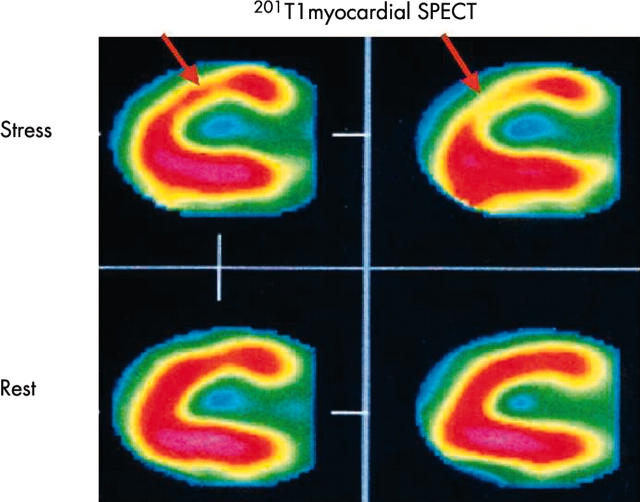Abstract
Background: The heart may be involved in children affected with sickle cell disease (SCD) via several mechanisms. Principally, chronic anaemia increases cardiac output and may cause left ventricular enlargement and cardiac insufficiency.
Aims: To investigate whether the heart also suffers from ischaemia in SCD, as has already been shown for other organs (bone, brain, etc), and to look for risk factors predisposing to this complication.
Methods: Twenty two children with SCD, and chest pain or ECG or echocardiographic signs (left ventricle dilation or hypokinesis) suggesting myocardial ischaemia were subjected to thallium-201 (201Tl) single photon emission computed tomography (SPECT).
Results: Eight children had a normal SPECT, 14 an abnormal one. Myocardial perfusion defects were reversible in nine, fixed in five. Patients with perfusion defects tended to be older and have more severe disease. Five had had cardiac symptoms (episodes of cardiac failure in three, ventricular fibrillation in one, angina in one). Myocardial perfusion was reassessed after six months of hydroxyurea treatment in three patients, and was found to be improved.
Conclusions: Myocardial perfusion defects are present in children with SCD and may be demonstrated using SPECT. Hydroxyurea improved perfusion in three patients.
Full Text
The Full Text of this article is available as a PDF (327.6 KB).
Figure 1 .
201Tl myocardial SPECT: reversible defect in the anterior wall, left ventricular cavity dilated.
Selected References
These references are in PubMed. This may not be the complete list of references from this article.
- Charache S., Terrin M. L., Moore R. D., Dover G. J., Barton F. B., Eckert S. V., McMahon R. P., Bonds D. R. Effect of hydroxyurea on the frequency of painful crises in sickle cell anemia. Investigators of the Multicenter Study of Hydroxyurea in Sickle Cell Anemia. N Engl J Med. 1995 May 18;332(20):1317–1322. doi: 10.1056/NEJM199505183322001. [DOI] [PubMed] [Google Scholar]
- Covitz W., Espeland M., Gallagher D., Hellenbrand W., Leff S., Talner N. The heart in sickle cell anemia. The Cooperative Study of Sickle Cell Disease (CSSCD). Chest. 1995 Nov;108(5):1214–1219. doi: 10.1378/chest.108.5.1214. [DOI] [PubMed] [Google Scholar]
- Ferster A., Tahriri P., Vermylen C., Sturbois G., Corazza F., Fondu P., Devalck C., Dresse M. F., Feremans W., Hunninck K. Five years of experience with hydroxyurea in children and young adults with sickle cell disease. Blood. 2001 Jun 1;97(11):3628–3632. doi: 10.1182/blood.v97.11.3628. [DOI] [PubMed] [Google Scholar]
- Gerry J. L., Bulkley B. H., Hutchins G. M. Clinicopathologic analysis of cardiac dysfunction in 52 patients with sickle cell anemia. Am J Cardiol. 1978 Aug;42(2):211–216. doi: 10.1016/0002-9149(78)90902-5. [DOI] [PubMed] [Google Scholar]
- Gladwin Mark T., Shelhamer James H., Ognibene Frederick P., Pease-Fye Margaret E., Nichols James S., Link Beth, Patel Daksesh B., Jankowski Marcin A., Pannell Lewis K., Schechter Alan N. Nitric oxide donor properties of hydroxyurea in patients with sickle cell disease. Br J Haematol. 2002 Feb;116(2):436–444. doi: 10.1046/j.1365-2141.2002.03274.x. [DOI] [PubMed] [Google Scholar]
- James T. N. Homage to James B. Herrick: a contemporary look at myocardial infarction and at sickle-cell heart disease: the 32nd Annual Herrick Lecture of the Council on Clinical Cardiology of the American Heart Association. Circulation. 2000 Apr 18;101(15):1874–1887. doi: 10.1161/01.cir.101.15.1874. [DOI] [PubMed] [Google Scholar]
- Kinney T. R., Helms R. W., O'Branski E. E., Ohene-Frempong K., Wang W., Daeschner C., Vichinsky E., Redding-Lallinger R., Gee B., Platt O. S. Safety of hydroxyurea in children with sickle cell anemia: results of the HUG-KIDS study, a phase I/II trial. Pediatric Hydroxyurea Group. Blood. 1999 Sep 1;94(5):1550–1554. [PubMed] [Google Scholar]
- Lester L. A., Sodt P. C., Hutcheon N., Arcilla R. A. Cardiac abnormalities in children with sickle cell anemia. Chest. 1990 Nov;98(5):1169–1174. doi: 10.1378/chest.98.5.1169. [DOI] [PubMed] [Google Scholar]
- Mansi Ishak A., Rosner Fred. Myocardial infarction in sickle cell disease. J Natl Med Assoc. 2002 Jun;94(6):448–452. [PMC free article] [PubMed] [Google Scholar]
- Martin C. R., Johnson C. S., Cobb C., Tatter D., Haywood L. J. Myocardial infarction in sickle cell disease. J Natl Med Assoc. 1996 Jul;88(7):428–432. [PMC free article] [PubMed] [Google Scholar]
- Norris S., Johnson C. S., Haywood L. J. Sickle cell anemia: does myocardial ischemia occur during crisis? J Natl Med Assoc. 1991 Mar;83(3):209–213. [PMC free article] [PubMed] [Google Scholar]
- Rees A. H., Stefadouros M. A., Strong W. B., Miller M. D., Gilman P., Rigby J. A., McFarlane J. Left ventricular performance in children with homozygous sickle cell anaemia. Br Heart J. 1978 Jun;40(6):690–696. doi: 10.1136/hrt.40.6.690. [DOI] [PMC free article] [PubMed] [Google Scholar]
- Rubler S., Fleischer R. A. Sickle cell states and cardiomyopathy. Sudden death due to pulmonary thrombosis and infarction. Am J Cardiol. 1967 Jun;19(6):867–873. doi: 10.1016/0002-9149(67)90510-3. [DOI] [PubMed] [Google Scholar]
- Styles L. A., Lubin B., Vichinsky E., Lawrence S., Hua M., Test S., Kuypers F. Decrease of very late activation antigen-4 and CD36 on reticulocytes in sickle cell patients treated with hydroxyurea. Blood. 1997 Apr 1;89(7):2554–2559. [PubMed] [Google Scholar]
- UZSOY N. K. CARDIOVASCULAR FINDINGS IN PATIENTS WITH SICKLE CELL ANEMIA. Am J Cardiol. 1964 Mar;13:320–328. doi: 10.1016/0002-9149(64)90447-3. [DOI] [PubMed] [Google Scholar]
- de Montalembert M., Bégué P., Bernaudin F., Thuret I., Bachir D., Micheau M. Preliminary report of a toxicity study of hydroxyurea in sickle cell disease. French Study Group on Sickle Cell Disease. Arch Dis Child. 1999 Nov;81(5):437–439. doi: 10.1136/adc.81.5.437. [DOI] [PMC free article] [PubMed] [Google Scholar]
- de Montalembert M., Davies S. C. Is hydroxyurea leukemogenic in children with sickle cell disease? Blood. 2001 Nov 1;98(9):2878–2879. doi: 10.1182/blood.v98.9.2878. [DOI] [PubMed] [Google Scholar]
- de Pontual L., Acar P., de Montalembert M., Villain E., Maunoury C., Sidi D., Kachaner J. L'ischémie myocardique: une complication méconnue de la drépanocytose chez l'enfant. A propos de deux observations. Arch Pediatr. 1999 Feb;6(2):178–181. doi: 10.1016/s0929-693x(99)80206-1. [DOI] [PubMed] [Google Scholar]



